Abstract
Interfacial performance is quite significant for maintaining the structural performance of steel–concrete composite structures. Quantitative assessment on the interfacial effect is critical. For this reason, theoretical investigation on the interfacial interaction of steel–concrete composites was performed, with the symmetry of the model considered. Influence of interfacial slip on the mechanical properties of the composites was considered. Analytical solutions of the interfacial slip and strain were provided. The accuracy of the predictions from the improved analytical model was validated by comparing them against the results from experimental and numerical studies. The influence of design parameters of the composite members on the interfacial effect was discussed. The proposed analytical model was also employed to assess the effect of the bond developing at the interface between concrete and steel on the deformation exhibited by simple composite structural forms (e.g., beams). Through the analysis, the priority design parameters of the composite structures are determined for controlling the level of interfacial slip in order to achieve optimum bearing capacity. Different to commonly used energy methods, numerical methods and finite element methods, the study provides a simple and straightforward analytical solution for describing the interfacial interaction of composite structures for the first time, which can act as scientific instruction for the interfacial slip control of composite materials and structures.
1. Introduction
Composites (i.e., carbon fiber reinforced polymer (CFRP) composites, steel–concrete composites and nanomaterial composites) have been widely used in engineering for their advanced bearing capacity, large stiffness, small deformation, low cost, light weight, and convenient fast construction [1,2,3]. The interfacial characteristics are the major concern for composite members usually constituted of multi-layer laminates with no less than two kinds of materials [4,5]. One of the extensively popular composites is the steel–concrete composite structure, typically consisting of a concrete slab and a steel beam usually connected at their interface through the use of shear studs. Due to the high load-carrying capacity and stiffness, this type of structure has been extensively used for constructing the decks of bridges, floor plates of industrial plants, and high-rise buildings. Unlike ordinary steel or reinforced concrete structures, the steel–concrete composite structures provide full use of the tensile strength of steel material and compressive strength of concrete material. Therefore, the behavior of a composite member is generally characterized by high load-carrying capacities and stiffness. Such members are lightweight (especially when compared to RC or prestressed concrete beams) and their use is characterized by significant technical and economic benefits during the construction process. As a consequence, their use has become increasingly popular in China’s super high-rise and long-span engineering structures in recent years.
When the action of ambient temperature and short/long-term load exceeds the limit state of normal use or bearing capacity, composite structures may suffer from strength or instability failure. The failure modes can be characterized with the patterns of ductile bending fracture, the concrete slab collapse, the buckling of the steel beam, and the steel web yielding. In addition, the structural performance of the composite beam is also affected by the interface slip damage. The shear connectors between the concrete slab and steel beam can be deformed due to the transfer of shear forces, resulting in the relative slip on the contact interface between the concrete slab and the steel beam. The occurrence of interfacial slip can lead to negative effects, such as reduced stiffness, increased deflection, and reduced elastic flexural capacity of the composite beam. The Steel Structure Design Specification (GBJ17-88) suggests that the elastic conversion cross-section method can be used to calculate the deflection of composite beams; however, it does not take the slip effect into account, and is actually rather unsafe [6,7]. The structural performance degradation or potential damage induced by the slip may lead to the global failure of the composite beam. Therefore, it is necessary to study the occurrence mechanism and influencing factors of the interfacial slip, so as to control the slip and condition evaluation of the composite beam structure.
Different types of interfacial constitutive models and hypotheses have been introduced to obtain the stress distribution, deformation law, and load-bearing performance of composite structures in consideration of the interfacial slip [8,9]. The earliest research was originated in 1951. Newmark et al. [10] assumed the elastic concrete and steel and the linear “load-slip” relationship of the connector, established the differential governing equation with respect to the interfacial shear force of composite beams, and obtained the analytical equation of the deflection curve after ignoring the lifting effect. Afterwards, Adekola [11] considered the partial interaction in the interfacial constitutive equations, established the deflection and in-plane stress formula of the slab by series solutions, and proved that the deflection was not influenced by the interaction beyond a limiting degree being obtained. Girhammar et al. [12] provided the exact and approximate closed-form deflection solutions of composite beams with partial interaction subjected to general dynamic loadings. Oehlers et al. [13,14] discussed the influence of partial interaction on the full shear connection strength of a composite beam, and how the strain in the steel element can be reduced. Fabbrocino et al. [15] introduced a moment–curvature generalized relationship for the cross-section, and a non-linear analysis on the structural behavior of the composite beam under sagging moment with interfacial slip considered was proposed. Dezi et al. [16] used the virtual work principle to establish the deformation differential control equation of the composite beam with the slip and time-varying effect considered. Nie et al. [17,18] studied the stiffness reduction degree of the composite beams and composite frame beams under specific constraints with consideration of slip effect. The elastic bearing capacity affected by slip effect under negative bending moment was also analyzed [19]. Jiang et al. [20,21] used Goodman’s elastic interlayer hypothesis to define the interfacial constitutive relationship, and established the deflection theoretical equations by considering the slip and shear effects based on the principle of minimum potential energy and the variational method. Gara and Ranzi et al. [22,23,24,25,26,27] provided a comparative study (i.e., finite element method, direct stiffness method) of the transient and steady analysis on composite beams with partial interaction based on the age-adjusted effective modulus method. The time (kinematical) effects on the structural performance were also considered in the direct stiffness (displacement)-based models [28,29,30]. Faella et al. [31] reported a closed-form formula of the stiffness matrix of the composite beams with partial interaction in linear elastic stage by using one element per member. Nguyen et al. [32,33] considered the creep and shrinkage effect of concrete slabs for the linear and nonlinear time-dependent analysis of composite beams, and space-exact and time-discretized deflection solutions with the interfacial slip were presented. Miao and Chen [34] derived the analytical equations of section stress, deformation, and deflection of composite beams by considering inter-layer slip based on the principle of minimum potential energy and Goodman’s elastic interlayer hypothesis. Zanuy [35] presented an analytical model to quantify deflections of composite beams with partial interaction. Uddin et al. [36,37] developed an arc-length method based on energy dissipation for the inelastic response description of steel–concrete composite beams with partial interaction. Bertagnoli et al. [38] considered the thermal and time effect on the shrinkage and creep behavior of concrete slab and the stress distribution of the composite beams with partial interaction. Shamass and Cashell [39] provided a simplified analytical solution to predict the plastic bending capacity of stainless steel–concrete composite beams with full or partial shear connection. Huang et al. [40] developed an incremental differential model to describe the stress and deflection of composite beams with the influence of interfacial slip, shrinkage and creep of precast slabs and post-pouring joints considered. It can be noted that both the theoretical analysis and the finite element method have been adopted to discuss the performance of composite structures with partial or full interaction. The different assumptions can result in distinguished and complicated inferences and solutions. For the general design of practical engineering, the straightforward and properly simplified theoretical models are particularly required for interfacial damage control and structural performance assessment.
For this reason, a simplified theoretical analysis has been performed to check the influence of interfacial slip on the behavior of the steel–concrete composite beams. The theoretical model is based on certain assumptions and the analytical solutions of the interfacial slip, strain and deflection of the composite beams have been provided. Experimental results have been adopted to check the feasibility of the proposed formula. Sensitivity analysis of the material and geometrical parameters has been conducted for the optimum design of the composite beams. A comparison of the deflections exhibited by composite beams when accounting or ignoring interfacial slip is also carried out.
2. Interfacial Interaction of the Composite Structures
2.1. Model Description and Assumption
For the steel–concrete composite beam structure, when the steel beam is in the elastic stage, the maximum compressive stress of the concrete slab is also in the rising section of the stress-strain curve, which has been demonstrated by considerable experiments and numerical calculation results [17,18,19]. Therefore, the concrete slabs and steel beams can be approximately regarded as elastomers in the mechanical model of composite beams with the interfacial slip considered. To analyze the influence of interfacial slip on composite beams with simple supports, the case that the concentrated load is applied at mid-span is taken as an example, as shown in Figure 1. The stress state of the infinitesimal element of the composite beam is displayed in Figure 2.

Figure 1.
Simple supported composite beam and cross-section model.
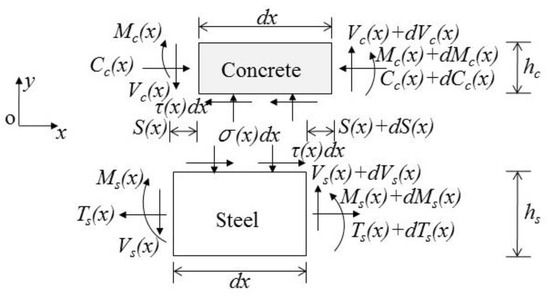
Figure 2.
Internal force distributions of the infinitesimal elements of composite beams.
Simultaneously, the following assumptions referring to the theoretical analysis of the composite beam are also made:
- (1)
- The interfacial shear stress is proportional to the slip, which giveswhere is the longitudinal spacing of shear studs (mm); is the interfacial shear stress per unit length (N/mm); is the shear stiffness of shear studs (N/mm); and is interfacial slip between the steel beam and concrete slab (mm).
- (2)
- The steel beam and the concrete slab have the equivalent curvature, and both follow the plane cross-section hypothesis. Thus, the relationship between the curvature and the strain can be established. An infinitesimal element of the composite beam, , is selected to be approximately equivalent to an arc segment. When the micro-arc section has an angle, , (i.e., the tangent angle corresponding to the micro-arc section), as shown in Figure 3, the tensile strain at the bottom of the concrete slab can be obtained from the geometric relationship:
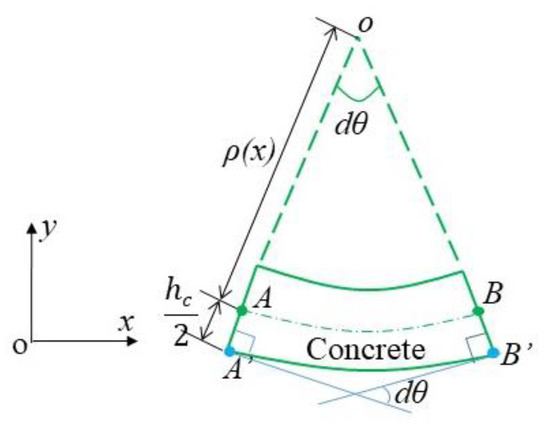 Figure 3. Deformation model of a micro-segment of the concrete slab.
Figure 3. Deformation model of a micro-segment of the concrete slab.
For arcs, there is a reciprocal relationship between the curvature and the radius of the arc:
Therefore, Equation (2) can be rewritten as
The physical relationship and the bending stress of the beam separately generate:
By using Equations (2)–(5), the relationship between the curvature and the bending moment of the concrete slab can be obtained as
Similarly, the relationship between the curvature and the bending moment of the steel beam can be expressed as
2.2. Theoretical Modeling
The interfacial strain, , is defined as the differential of the slip with respect to , and is also equivalent to the difference between the strains of the concrete slab and the steel beam, which gives:
is introduced to describe the interfacial shear force at the point. Since stands for the shear force in unit length at the point, the shear force can be expressed as
where . According to the assumption (1), the following equation can be given by
The differential of Equation (10) with respect to gives:
The interfacial strain, , is mainly composed of two parts: (1) the interfacial shear force induced axial strains of the steel beam and the concrete slab, marked as ; (2) the bending action induced axial strain, marked as . According to the stress models in Figure 2 and the assumption (2), the axial strains can be separately expressed as:
According to Equations (8), (12a) and (12b), it yields:
Since the composite beam is under the action of central point load , as shown in Figure 1, the bending moment at the left half span can be given by
And considering the relationships between the bending moments, curvatures and loads in Equations (7) and (14), the curvature can be rewritten as
Substituting Equations (11) and (15) into Equation (13) generates:
To abbreviate the second-order differential control equation into the standard form, constant coefficient and are introduced:
And then Equation (16) can be simplified as
The general solution form of Equation (18) can be given by
where the constant coefficients and are to be determined by the boundary conditions.
By considering Equations (9) and (10), the interfacial shear force in unit length and the interfacial slip can be expressed as
By using the boundary condition that the interfacial slip at the symmetrical center is 0, the following equation can be obtained:
The axial force at the left end side of the beam should be 0, which generates , and then according to Equation (19), it yields . Thus, the constant can be figured out from Equation (21) and its form is
And then the interfacial slip in the left half span of the beam can be expressed as
The bending moment in the right half span of the composite beam in Figure 1 can be denoted as
And similarly, considering the relationships between the bending moments, curvatures and loads in Equations (7) and (24), the curvature can be can be rewritten as
Substituting Equations (11) and (25) into Equation (13) generates:
By introducing Equation (17) to replace the constant term, the above formula can be simplified as
The general solution form of Equation (27) can be given by
where the constant coefficients and can be determined by the boundary conditions.
In a similar way, the interfacial shear force in unit length and the interfacial slip can be expressed as
By using the boundary condition that the interfacial slip at the symmetrical center is 0, the following equation can be obtained:
The axial force at the right end side of the beam should be 0, which generates , and then the following formula can be derived from Equation (28):
By using Equations (30) and (31), the constants and can be figured out:
And then the interfacial slip in the right half span of the beam can be expressed as
By using Equation (8) and taking the differential of Equations (23) and (33) with respect to , the interfacial strain, , can be obtained:
2.3. Discussions on the Analytical Solution
Based on the theoretical investigation, an example has been introduced to discuss the distribution of interfacial slip, interfacial strain, and curvature of the steel–concrete composite beam along the span. The cross-section and correlated parameters are displayed in Figure 4. C30 concrete and Q235 steel beam are adopted, and the geometrical and physical parameters are listed in Table 1. The profile of the interfacial slip along the span can be figured out by Equations (23) and (33), as shown in Figure 5. In a similar way, the profiles of the interfacial strain and the curvature of the composite beam can separately follow Figure 6 and Figure 7.

Figure 4.
Cross-section dimensions and materials of composite beams.

Table 1.
Geometrical and physical parameters of the composite beam.
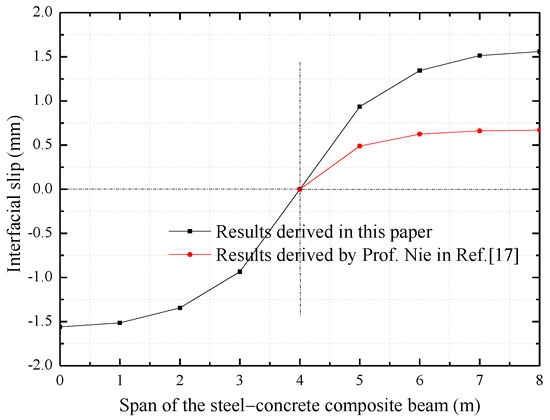
Figure 5.
Distribution of interfacial slip along the span of composite beams.
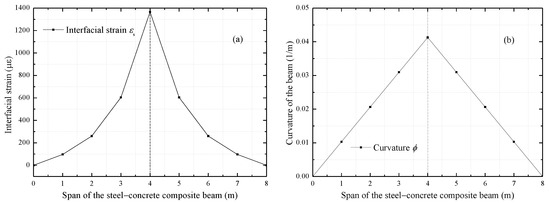
Figure 6.
Distribution of (a) interfacial strain and (b) curvature along the span of composite beams.

Figure 7.
Configuration of the steel–concrete composite beam in Ref. [15].
It can be noted from Figure 5 that the interfacial slip is in antisymmetric shape along the span of the beam. The slip at the symmetric central of the beam is 0, and the slips at the two ends of the beam reach the maximum, with value equal to 1.41 mm. The interfacial slip of the right half span derived in Ref. [17] is presented in red color in Figure 5. Similar tendency in the right half span is observed, but the maximum slip at the right end of the beam in Ref. [17] is 0.63 mm. The gap between the two curves may be attributed to the different assumptions and derivations in the theoretical analysis. Besides, the study in Ref. [17] just gave a solution for the right half span, and the derivation was difficult to extend to the left half span. The improvement of the proposed theoretical model is that the analytical equations to describe the interfacial characteristics for the whole span are given. Different to the energy and variational methods, semi-numerical method, and finite element method presented in Refs. [20,21,22,23,24,25,26,27,28,29,30,31,32,33,34,35,36,37,38,39,40], the theoretical study provides a function with structural characteristic parameters included for understanding the interfacial interaction based on classical mechanical theory. Since the current bond–slip models are generally established on the composites under tensile/compression actions, the analytical solution correlated to the interfacial shear stress and slip can be used to configure the improved interfacial constitutive model of the composite structures subjected to bending action.
Figure 6a shows the symmetric distribution of interfacial strain along the span of the composite beam. The interfacial strain has the maximum value at the midspan, and the values at two ends of the beam are 0. The interfacial strain profile decreases nonlinearly from the midspan to the ends. Figure 6b indicates the symmetric distribution of the curvature along the span of the composite beam. The curvature reaches the maximum value at the midspan and becomes 0 at the two ends of the beam. The curvature profile decreases linearly from the center to the ends of the beam. The two profiles in Figure 6 indicate that large deformation exists at the midspan of the composite beam and the correlated interaction is strong, which may lead to interfacial defect.
3. Analytical Model Validation Based on Testing Results
To check the accuracy and effectiveness of the proposed theoretical formula, the comparison study with experimental results has been conducted. A simply supported steel–concrete composite beam tested by Fabbrocino et al. [15] is introduced. The cross-section of the composite beam is shown in Figure 7. C35 concrete is adopted, with equal to 3.15 × 104 MPa. The elastic modulus of the IPE400 steel beam is 2.06 × 105 MPa. The effective span length is 5 m. Eighteen shear studs with longitudinal spacing of 650 mm are adopted in two rows. Point load 257 kN is applied on the midspan of the composite beams. Substituting the correlated parameters into Equations (23) and (33), the distribution of the interfacial slip can be figured out. The interfacial slip derived from the theoretical study in this paper, the measured interfacial slip by experimental study, and the numerical results provided by Fabbrocino et al. [15] can be followed in Figure 8. The standard deviation for the three interfacial slip curves have also been included in Figure 8.
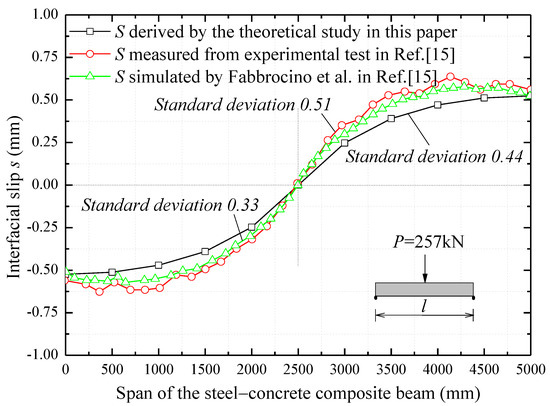
Figure 8.
Comparison of the derived interfacial slip with the experimental result and the simulated value conducted by Fabbrocino et al. in Ref. [15].
It can be seen from Figure 8 that the interfacial slip derived from the theoretical study in this paper corresponds well with the experimental and the simulated results performed by Fabbrocino et al. in Ref. [15], which validates the effectiveness and correctness of the theoretical analysis. The small gap existing in the profiles may be attributed to the ignorance of the self-weight of the composite beam in the theoretical study. It explains that the theoretical values are generally a little smaller than the tested ones along the span of the composite beam. As a whole, the derived formulas Equations (23) and (33) can be used to accurately describe the interfacial slip of the composite beam, and the derived interfacial strain can be also adopted to describe the interfacial interaction of the composite beam.
To further emphasize the feasibility of the proposed analytical solution, another composite beam from Ref. [20] is also introduced to provide proofreading. The structure of the specimen follows Figure 9. Substituting related parameters of the composite beam into the Equations (23) and (33), the distributions of the interfacial slip along the whole span under different point loads are separately presented in Figure 10a,b. The experimental results and the results provided by energy method in Ref. [20] are also provided in Figure 10. The comparison indicates that the proposed analytical solution can accurately describe the interfacial slip of the composite beam.
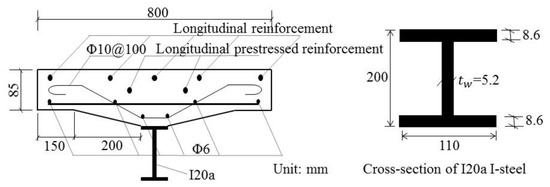
Figure 9.
Configuration of the steel–concrete composite beam in Ref. [20].
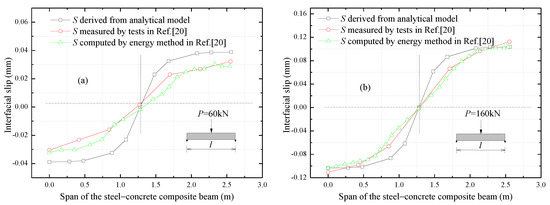
Figure 10.
Comparison of the derived interfacial slip with the experimental result and the energy method conducted by Jiang et al. in Ref. [20].
Given the analysis above, it can be noted that the theoretical analysis has been validated by the experimental studies, the numerical method, and the energy method given in published references. Therefore, the proposed analytical solution can be considered as an independent way to understand the interfacial interaction of the steel–concrete composite beam. Based on the theoretical study, sensitive analysis of the composite beam can be further performed to explore the impact of correlated material and geometrical parameters on the incurrence of interfacial slip damage.
4. Improved Interfacial Design Based on Parametric Analysis
To understand the influence of the geometrical and physical parameters of the composite beam on the slip effect, it is necessary to explore the sensitivity of the relevant parameters to the interfacial slip, so as to guide the design of the composite beam structure to realize the optimal control of its structural performance [41]. It can be seen from Figure 11, Figure 12, Figure 13 and Figure 14 that the interfacial slip closer to the midspan of the composite beam becomes smaller (comparison with its absolute value, the same as below), and the interfacial slip becomes 0 in the midspan. The interfacial slip becomes greater farther away from the mid-span interface, and has the maximum at the end supports of the composite beam.

Figure 11.
Variation of the interfacial slip with the shear stiffness of shear studs.
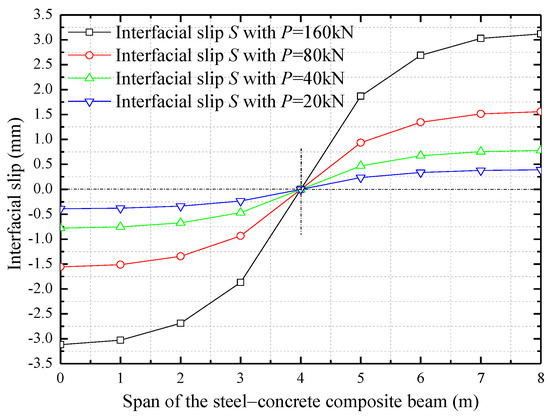
Figure 12.
Variation of the interfacial slip with the load at midspan.
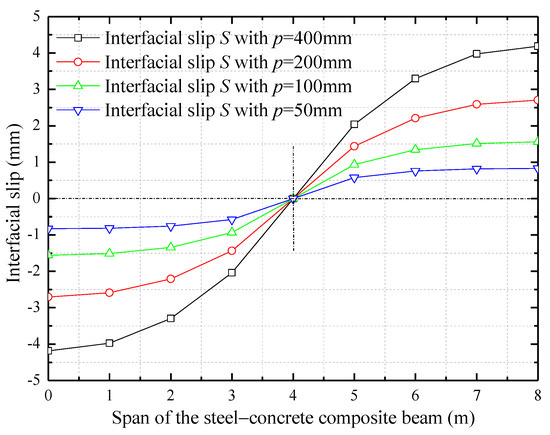
Figure 13.
Variation of the interfacial slip with the longitudinal spacing of shear studs.
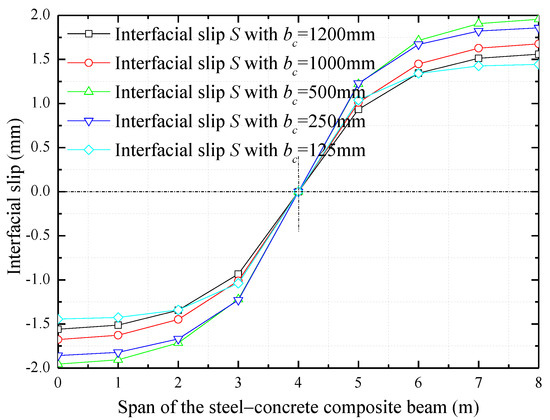
Figure 14.
Variation of the interfacial slip with the width of concrete slab.
Figure 11 shows the influence of shear stiffness of shear studs on the interface slip. When increases from 3300 N/mm to 66,000 N/mm, the interfacial slips of the composite beam present a relatively obvious decreasing trend. In other words, the greater shear stiffness of the shear connection can make the composite beam structure less likely to suffer from interfacial slip effect. When increases from 3300 N/mm to 6600 N/mm, there is a significant decrease in interfacial slips, with a reduction of at the end support up to 1.46 mm. When increases from 6600 N/mm to 33,000 N/mm, the interfacial slips show a large drop, with a reduction at the end support up to 3.13 mm. When increases from 33,000 N/mm to 66,000 N/mm, the decreasing amplitude of the interfacial slips significantly minimize. This indicates that when the stiffness of shear connection is relatively small, increasing the stiffness can significantly improve the interfacial performance of the composite beams. When the stiffness of shear connection is much larger, the effect of appropriately increasing the stiffness on improving the interfacial performance of the composite beams is weak. Therefore, in the engineering design, it is necessary to reasonably design the shear stiffness of the interface of the composite beam. Shear connection with relatively large stiffness (e.g., = 33,000 N/mm) can be selected to reduce the interfacial slip and enhance the performance of the composite beam.
Figure 12 shows the influence of concentrated load on the interfacial slip. When the load increases from 20 kN to 160 kN, the interfacial slips show a gradual increasing trend. When is 160 kN, the maximum interfacial slip at the end support of the composite beam with a span of 8 m is only 3.12 mm. When is 20 kN, the maximum interfacial slip is just 0.39 mm. In other words, when the composite beam is less loaded, the interfacial slip effect can be ignored. When increases from 80 kN to 160 kN, the maximum interfacial slip increases from 1.56 mm to 3.12 mm. When the load is below 100 kN, the maximum interfacial slip of the composite beam is less than 1.95 mm, and the interfacial slips are generally small. Compared with Figure 11, it can be seen that the increase or decrease of the load has a relatively small impact on the interfacial slip, and the slip effect of the composite beam can be ignored under small load.
Figure 13 shows the effect of the longitudinal spacing of shear studs on the interfacial slip of the composite beams. When the longitudinal spacing of shear studs increases from 50 mm to 400 mm, the interfacial slip has a large increase. That is, when the number of shear connectors changes from dense to sparse, the interfacial bond strength of the composite beam decreases, resulting in a growth of interfacial slip. Therefore, on the basis of meeting the basic requirements of design and construction specifications, construction feasibility, convenience and other factors, appropriately increasing the number of shear connectors can effectively reduce the occurrence of interfacial slip.
Figure 14 shows the effect of the width of concrete slab on the interfacial slip. When the width of the concrete slab decreases from 1200 mm to 500 mm, the interfacial slip of the composite beam increases slightly. When the width of the concrete slab decreases from 500 mm to 125 mm, the interfacial slip of the composite beam decreases significantly. The influence of bc on the interfacial slip is in nonlinear form. When the width of the concrete slab is the same as the width of the steel beam, the interfacial slip is generally small in the entire beam span and the value is within 1.5 mm. When the width of concrete slab is four times the width of the steel beam (namely, = 500 mm), the interfacial slip in the entire beam span has the largest slip, with maximum value less than 2 mm. When the width of concrete slab is eight times the width of the steel beam (namely, = 1000 mm), the interfacial slip decreases greatly with most of the values along the entire beam span smaller than 1.7 mm, and the maximum value at the end support is about 1.68 mm. This means that an optimum design on the width of concrete slab exists to achieve the best interfacial bonding state. Therefore, proper control of the width of concrete slab can reduce the interfacial slip of the composite beam. Furthermore, compared with the sensitive parameters in Figure 11, Figure 12 and Figure 13, the width of concrete slab is relatively less sensitive to the slip effect, and so other parameters can be given priority in design.
In summary, it can be seen that the change of shear stiffness of shear studs in composite beam has the greatest influence on the interface. When the shear stiffness of shear studs degrades obviously, the interface is prone to slip. Secondly, the density of shear connectors also has a great impact on the interface slip, and the failure of local shear connectors is likely to induce interface slip. Finally, the load applied on the composite beam contributes a relatively large effect to the interfacial slip, and the relatively less sensitive factor is the width of the concrete slab. Therefore, in the design of the composite beam, priority should be given to the design of the shear stiffness and the longitudinal spacing of shear studs to achieve the optimal control of the interfacial strength of the composite beam. After that, the ultimate load of the composite beam structure and the width of concrete slab can be considered in turn to obtain the best interfacial connection performance and avoid the occurrence of interfacial slip.
5. Slip-Induced Deformation Properties of Composite Structures
To explore the slip effect on the bearing capacity of composite structures, deflections of the composite beam with and without the consideration of interfacial slip are analyzed, respectively.
5.1. Deflection of the Composite Beam without the Slip Effect
Deflection calculation can be obtained from the approximate relationship between beam deflection and bending moment in material mechanics. For the composite beam, when the slip effect is ignored, the elastic conversion cross-section method can be used, and the relationship of deflection and bending moment of the composite beam can be expressed as
where the equivalent cross-section moment of inertia , , , , is the distance between the centers of gravity of the steel beam and the concrete slab.
When , the relationship between the deflection and the load of the composite beam can be established:
Taking the quadratic integral of the above equation with respect to , the deflection equation of the composite beam can be obtained:
where and are constant coefficients and can be determined by boundary conditions. When the deflection at the left support is 0, it can be derived from Equation (37) that . The midspan deflection reaches the maximum value, and thus its first derivative is 0, which yields , and thus gets . Therefore, ignoring the slip effect, the deflection equation of composite beam can be expressed as
When , the relationship between the deflection of the composite beam and load can be established:
Taking the quadratic integral of the above equation with respect to , the deflection equation of the composite beam can be obtained:
where and are constant coefficients and can be determined by boundary conditions. Since the deflection at the right support is 0, it yields . The midspan deflection reaches the maximum value, and then its first derivative is 0, which thus gives . Then, another constant can be figured out, . Therefore, the deflection of the composite beam with the slip effect ignored can be expressed as
It can be seen from the above analysis that the deflection of the composite beam with the slip effect ignored can be obtained by using the conversion cross-section method, and illustrated with Equations (38) and (41). By substituting the relevant parameters in Table 1 into the deflection equation, the distribution characteristics of the deflection of the composite beam along with the variation of the span can be obtained, as shown in Figure 15. It indicates that with the increase of beam span, the deflection of the composite beam increases sharply, especially for the midspan deflection. For example, a beam with a 4 m span has a midspan deflection of 11.01 mm, while a beam with an 8 m span has a midspan deflection of 88.06 mm.
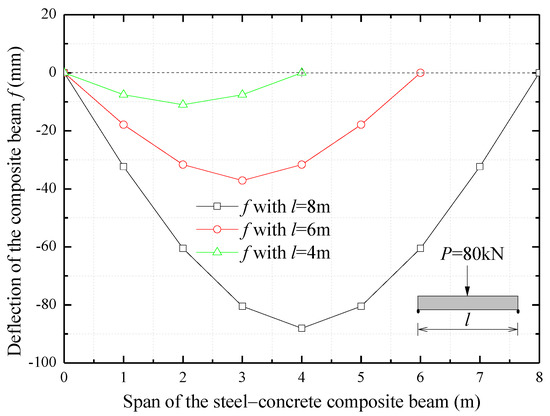
Figure 15.
Deflection of the composite beam with the slip effect ignored.
5.2. Slip-Induced Additional Deflection of the Composite Beam
The algorithm method of the deflection of the composite beam by considering the slip effect can be as follows. According to assumption (2), the interfacial strain induced additional curvature can be expressed as
By using Equation (7), the relationship of curvature and total bending moment of the composite beam can be given . The additional bending moment can thus be expressed as , and then by considering Equation (35), the additional deflection can be obtained:
Substituting Equations (34a) and (34b) into Equation (43) to replace , and taking the quadratic integral of Equation (43) with respect to , it yields:
Introducing the boundary condition that , it gives . Adopting the ultimate condition that , it gives . Thus, the additional deflection in the interval [0, ] can be given by
In a similar way, the additional deflection in the interval [, ] can be expressed as
where the constants and are given by
The additional deflection of the composite beam induced by the slip effect can be provided by Equations (45) and (46). By substituting the relevant parameters in Table 1 into the additional deflection equation, the distribution characteristics of the additional deflection of the composite beam along with the variation of the span can be obtained, as shown in Figure 16. It can be noted that the additional deflection has a similar shape to the deflection of the composite beam, and the maximum value is at the midspan. The increase in the beam span causes additional deflection of the composite beam, especially for the midspan deflection. For example, the additional deflection at the midspan of the beam with a 4 m span is 2.70 mm, while the additional deflection at the midspan of the beam with an 8 m span is up to 8.71 mm. This indicates that the slip effect-induced additional deflection should be carefully considered, especially for relatively long beams. A comparison of the deflection at the midspan of the composite beam with the slip effect considered and ignored is displayed in Table 2. It shows that the additional deflection increases with the growth of the span, while the weight of the additional deflection on the deflection of the beam decreases with the growth of the span. Therefore, the influence of slip effect on the deformation of the composite beam with relatively short span should be carefully considered. The derived formula of the additional deflection can be used to judge the interfacial slip-induced bending stiffness degradation.
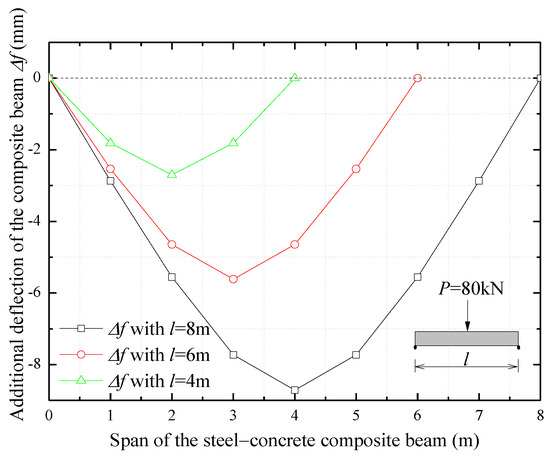
Figure 16.
Slip-induced additional deflection along the span of the composite beam.

Table 2.
Influence of slip on the midspan deflection of the composite beam.
It should be noted that when the steel–concrete composite beams are subjected to the uniform load or other loads, the slip-induced effect can be also established based on the proposed derivation, and the corresponding control measure can be given accordingly. Besides, when the composite structure suffers from other boundary conditions (i.e., fixed constraints), the analytical solution for the interfacial state can be provided by using a similar method. The study can be used to scientifically instruct the optimum design on the shear connection of steel–concrete composite structures and control the interfacial slip-induced stiffness degradation.
6. Conclusions
To understand the interfacial interaction and mechanical performance of the steel–concrete composite structures, a theoretical investigation on the interfacial slip-induced shear stress, strain and deformation properties of the composites has been conducted. Comparison with experimental and numerical results has validated the effectiveness of the theoretical model. The parametric sensitivity of the composite structures on the interfacial bonding state has been discussed. The analytical solutions of the interfacial slip and deformation of the composite structures have been proposed for instructing the optimal design. The following conclusions can be drawn from the study:
- (1)
- The analytical solution of the interfacial slip of the composite beam can be illustrated with Equations (23) and (33), and the interfacial strain can be described by Equations (34a) and (34b). The case of composite beams under uniform loads or other kinds of loads can be solved in a similar way. The study, for the first time, provides the closed-form solution for straightforwardly describing the interfacial interaction.
- (2)
- The comparison analysis with the results of experimental tests, numerical study and energy method performed by Fabbrocino et al. in Ref. [15] and Jiang et al. in Ref. [20], validates the predictions obtained by the proposed analytical model. This means the proposed model can be used for describing the interfacial interaction and structural performance of the composite beam.
- (3)
- Priority should be given to the design of interfacial shear stiffness and the longitudinal spacing of shear studs to achieve the optimal interfacial strength of the composite beam. The ultimate load and the width of concrete slab can be considered in turn to obtain the best interfacial connection performance and avoid the occurrence and propagation of interfacial slip.
- (4)
- The interfacial slip effect should be carefully considered for composite beams with relatively short spans (i.e., beams with about 8 m span). In general, the slip-induced deflection should be considered to judge the deformation and bearing capacity of the composite beam, since the slip-induced additional deflection can have a weight in the global deflection that cannot be ignored.
- (5)
- The analytical model describing the interfacial shear stress between the concrete slab and the top flange of the steel beam can be used to develop a constitutive model for the case of a composite beam subjected to bending. The latter model can be used to determine the effect of the interfacial slip on the load-carrying capacity and stiffness of the beam considered.
Author Contributions
Theoretical analysis, validation, writing, H.-P.W.; Writing and translation, T.S.; Check, J.-W.Y. and P.X.; Translation, S.-Y.F.; Suggestion, D.H. All authors have read and agreed to the published version of the manuscript.
Funding
The work described in this paper was supported by the National Natural Science Foundation of China (Grant No. 51908263), Double First-Class (First-Class University & First-Class Disciplines) Funds of Lanzhou University (Grant No. 561119201), the Fundamental Research Funds for the Central Universities (Grant No. lzujbky-2020-56), Key Laboratory of Structures Dynamic Behavior and Control (Ministry of Education) in Harbin Institute of Technology (Grant No. HITCE201901) and Provincial Projects (2020-0624-RCC-0013 and JK2021-18).
Institutional Review Board Statement
Not applicable.
Informed Consent Statement
Not applicable.
Data Availability Statement
The data supporting the results reported in the paper can be accessed from the corresponding authors.
Acknowledgments
Special thanks are due to Jinping Ou and Zhi Zhou of Dalian University of Technology, and Youhe Zhou and Ning Huang of Lanzhou University. The findings and opinions expressed in this article are only those of the authors and do not necessarily reflect the views of the sponsors.
Conflicts of Interest
No conflict of interest to declare.
References
- Metelli, G.; Cairns, J.; Conforti, A.; Plizzari, G.A. Local bond behavior of bundled bars: Experimental investigation. Struct. Concr. 2021, 1–16. [Google Scholar] [CrossRef]
- Zhang, Y.; Wang, M.; Yu, L.; Guo, X.; Liu, K.; Yang, H. Experimental research and mechanical analysis on the bond-slip behavior between concrete and corroded I-shaped steel. Struct. Concr. 2021, 1–15. [Google Scholar] [CrossRef]
- Al-Qaralleh, M.; Toutanji, H.; Eljufout, T. Overloading impact on the flexural behavior of RC beams strengthened with FRP composites under fatigue: Experimental study. Eng. Struct. 2020, 221, 111045. [Google Scholar] [CrossRef]
- Duvnjak, I.; Bartolac, M.; Damjanović, D.; Košćak, J. Performance assessment of a concrete railway bridge by diagnostic load testing. Struct. Concr. 2020, 21, 2363–2376. [Google Scholar] [CrossRef]
- Wang, H.; Dai, J.-G. Strain transfer analysis of fiber Bragg grating sensor assembled composite structures subjected to thermal loading. Compos. Part B Eng. 2019, 162, 303–313. [Google Scholar] [CrossRef]
- Nie, J.; Shen, J.; Yuan, Y. General formula for calculating the deformation of steel-concrete simply supported composite beams. Eng. Mech. 1994, 11, 1–7. [Google Scholar]
- Nie, J.; Shen, J.; Yu, Z. A reduced stiffness method for deformation calculation of steel-concrete composite beams with slip effect. J. Civ. Eng. 1995, 28, 11–17. [Google Scholar]
- Ranzi, G.; Leoni, G.; Zandonini, R. State of the art on the time-dependent behaviour of composite steel–concrete structures. J. Constr. Steel Res. 2013, 80, 252–263. [Google Scholar] [CrossRef]
- Zhang, S.; Xue, W.; Liao, X. Theoretical analysis on long-term deflection of GFRP-concrete hybrid structures with partial interaction. Compos. Struct. 2019, 216, 1–11. [Google Scholar] [CrossRef]
- Newmark, N.M.; Siess, C.P.; Viest, I.M. Tests and analysis of composite beams with incomplete interaction. Proc. Soc. Exp. Stress Anal. 1951, 9, 75–92. [Google Scholar]
- Adekola, A.O. The dependence of shear lag on partial interaction in composite beams. Int. J. Solids Struct. 1974, 10, 389–400. [Google Scholar] [CrossRef]
- Girhammar, U.A.; Pan, D. Dynamic analysis of composite members with interlayer slip. Int. J. Solids Struct. 1993, 30, 797–823. [Google Scholar] [CrossRef]
- Oehlers, D.J.; Sved, G. Composite beams with limited-slip-capacity shear connectors. ASCE J. Struct. Eng. 1995, 121, 932–938. [Google Scholar] [CrossRef]
- Oehlers, D.J.; Nguyen, N.T.; Ahmed, M.; Bradford, M.A. Partial interaction in composite steel and concrete beams with full shear connection. J. Constr. Steel Res. 1997, 41, 235–248. [Google Scholar] [CrossRef]
- Fabbrocino, G.; Manfredi, G.; Cosenza, E. Non-linear analysis of composite beams under positive bending. Comput. Struct. 1999, 70, 77–89. [Google Scholar] [CrossRef]
- Dezi, L.; Gara, F.; Leoni, G.; Tarantino, A.M. Time-dependent analysis of shear-lag effect in composite beams. ASCE J. Eng. Mech. 2001, 127, 71–79. [Google Scholar] [CrossRef]
- Nie, J.; Cai, C.S. Steel-concrete composite beams considering shear slip effects. ASCE J. Struct. Eng. 2003, 129, 495–506. [Google Scholar] [CrossRef] [Green Version]
- Huang, Y.; Nie, J.; Yi, W. Stiffness of steel-concrete composite frame beam with slip effect. Eng. Mech. 2012, 29, 88–92. [Google Scholar] [CrossRef]
- Fan, J.; Nie, J. Effects of slips on load-carrying capacity of composite beams under negative bending. Eng. Mech. 2005, 22, 177–182. [Google Scholar]
- Jiang, L.; Yu, Z.; Li, J. Theoretical analysis of slip and deformation of steel-concrete composite beam under uniformly distributed loads. Eng. Mech. 2003, 20, 133–137. [Google Scholar]
- Zhou, L.; Jiang, L.Z.; Yu, Z.W. Analysis of composite beams of steel and concrete with slip and shear deformation. Eng. Mech. 2005, 20, 133–137. [Google Scholar]
- Ranzi, G.; Bradford, M.A.; Uy, B. A direct stiffness analysis of a composite beam with partial interaction. Int. J. Numer. Methods Eng. 2004, 61, 657–672. [Google Scholar] [CrossRef]
- Gara, F.; Ranzi, G.; Leoni, G. Time analysis of composite beams with partial interaction using available modelling techniques: A comparative study. J. Constr. Steel Res. 2006, 62, 917–930. [Google Scholar] [CrossRef]
- Gara, F.; Ranzi, G.; Leoni, G. Displacement-based formulations for composite beams with longitudinal slip and vertical uplift. Int. J. Numer. Methods Eng. 2006, 65, 1197–1220. [Google Scholar] [CrossRef]
- Ranzi, G.; Gara, F.; Leoni, G.; Bradford, M.A. Analysis of composite beams with partial shear interaction using available modelling techniques: A comparative study. Comput. Struct. 2006, 84, 930–941. [Google Scholar] [CrossRef]
- Ranzi, G.; Bradford, M.A. Analytical solutions for the time-dependent behaviour of composite beams with partial interaction. Int. J. Solids Struct. 2006, 43, 3770–3793. [Google Scholar] [CrossRef] [Green Version]
- Ranzi, G.; Zona, A. A steel–concrete composite beam model with partial interaction including the shear deformability of the steel component. Eng. Struct. 2007, 29, 3026–3041. [Google Scholar] [CrossRef]
- Ranzi, G.; Bradford, M.A. Analysis of composite beams with partial interaction using the direct stiffness approach accounting for time effects. Int. J. Numer. Methods Eng. 2009, 78, 564–586. [Google Scholar] [CrossRef]
- Ranzi, G.; Dall’Asta, A.; Ragni, L.; Zona, A. A geometric nonlinear model for composite beams with partial interaction. Eng. Struct. 2010, 32, 1384–1396. [Google Scholar] [CrossRef]
- Gara, F.; Ranzi, G.; Leoni, G. Short- and long-term analytical solutions for composite beams with partial interaction and shear-lag effects. Int. J. Steel Struct. 2010, 10, 359–372. [Google Scholar] [CrossRef]
- Faella, C.; Martinelli, E.; Nigro, E. Steel–concrete composite beams in partial interaction Closed-form “exact” expression of the stiffness matrix and the vector of equivalent nodal forces. Eng. Struct. 2010, 32, 2744–2754. [Google Scholar] [CrossRef]
- Nguyen, Q.; Hjiaj, M.; Uy, B. Time-dependent analysis of composite beams with continuous shear connection based on a space-exact stiffness matrix. Eng. Struct. 2010, 32, 2902–2911. [Google Scholar] [CrossRef]
- Nguyen, Q.; Hjiaj, M. Nonlinear time-dependent behavior of composite steel-concrete beams. ASCE J. Struct. Eng. 2016, 142, 04015175-1-11. [Google Scholar] [CrossRef]
- Miao, L.; Chen, D. Closed-form solution of composite beam considering interfacial slip effects. J. Tongji Univ. Nat. Sci. 2011, 39, 1113–1119. [Google Scholar]
- Zanuy, C. Analytical equations for interfacial stresses of composite beams due to shrinkage. Int. J. Steel Struct. 2015, 15, 999–1010. [Google Scholar] [CrossRef]
- Uddin, A. A Nonlinear Finite Element Model for Steel-Concrete Composite Beam Using a Higher-Order Beam Theory. Ph.D. Thesis, The University of Adelaide, Adelaide, Australia, 2016. [Google Scholar]
- Uddin, A.; Sheikh, A.H.; Brown, D.; Bennett, T.; Uy, B. A higher order model for inelastic response of composite beams with interfacial slip using a dissipation based arc-length method. Eng. Struct. 2017, 139, 120–134. [Google Scholar] [CrossRef]
- Bertagnoli, G.; Gino, D.; Martinelli, E. A simplified method for predicting early-age stresses in slabs of steel-concrete composite beams in partial interaction. Eng. Struct. 2017, 140, 286–297. [Google Scholar] [CrossRef]
- Shamass, R.; Cashell, K.A. Analysis of stainless steel-concrete composite beams. J. Constr. Steel Res. 2019, 152, 132–142. [Google Scholar] [CrossRef]
- Huang, D.; Wei, J.; Liu, X.; Du, Y.; Zhang, S. Experimental study on influence of post-pouring joint on long-term performance of steel-concrete composite beam. Eng. Struct. 2019, 186, 121–130. [Google Scholar] [CrossRef]
- Wang, H.P.; Ni, Y.Q.; Dai, J.G.; Yuan, M.D. Interfacial debonding detection of strengthened steel structures by using smart CFRP-FBG composites. Smart Mater. Struct. 2019, 28, 115001. [Google Scholar] [CrossRef]
Publisher’s Note: MDPI stays neutral with regard to jurisdictional claims in published maps and institutional affiliations. |
© 2021 by the authors. Licensee MDPI, Basel, Switzerland. This article is an open access article distributed under the terms and conditions of the Creative Commons Attribution (CC BY) license (https://creativecommons.org/licenses/by/4.0/).